Welcome to the latest edition of Coasters-101: the definitive guide on roller coaster lift hills. What are lift hills? How do roller coasters reach their highest point? How do lift hills work? What angle are roller coaster lift hills? What types of lift hills are there? How has lift hill design changed over the years? What’s the latest lift hill technology? Keep reading to learn all this and more!
*Author’s Note: this article was originally published on 09/25/2013. It was updated on January 18, 2022*
**If you’d prefer a condensed version of this article, just scroll to the bottom and watch the video**
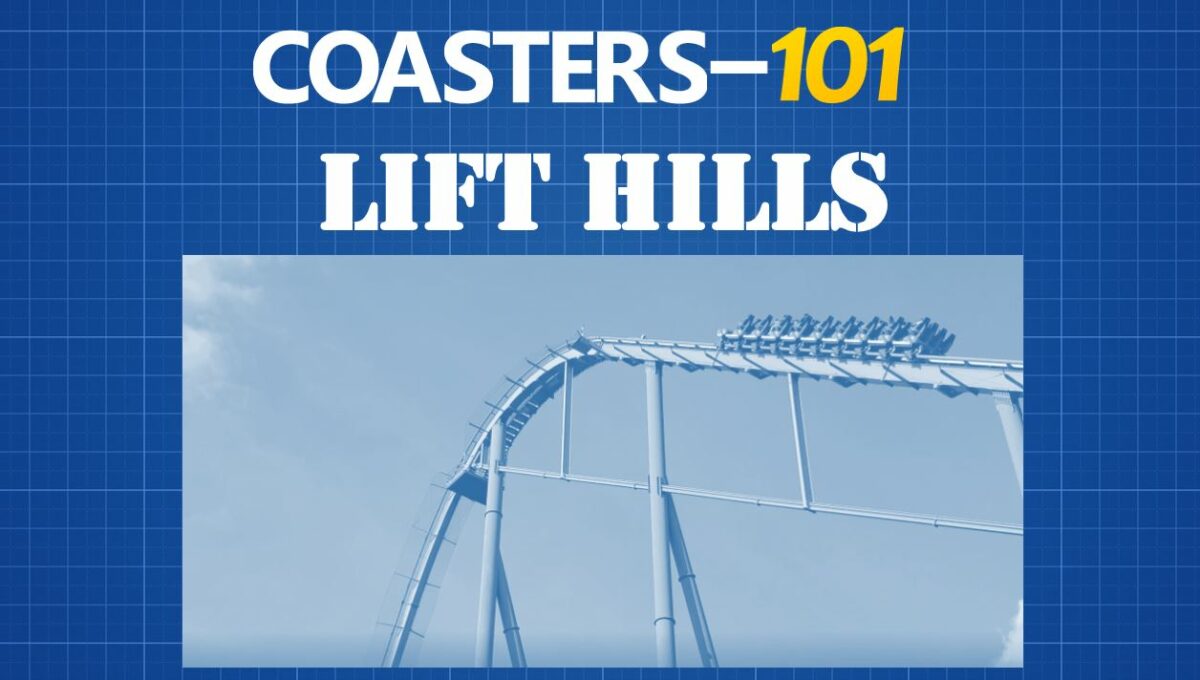
What is a lift hill?
A lift hill is a mechanism used to transport a roller coaster car or train up a hill to an elevated point. As the train is pulled to the top, it is gaining potential energy, or stored energy. Once released, the acceleration due to gravity makes the vehicles coast back to the station. The lift hill is usually the first and tallest hill on a roller coaster (but not always).
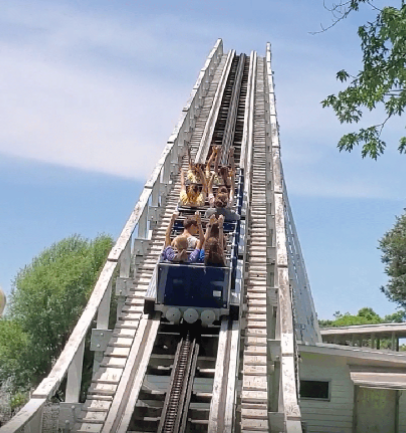
Most roller coasters only have one lift hill but they can have as many as required. Big Thunder Mountain at Disneyland Paris has four lift hills (if you know of a roller coaster that has more than four lift hills please do let me know! The Ultimate at Lightwater Valley uses eight different chains, but five are used like friction wheels in flat segments – I would only count three as lift hills).
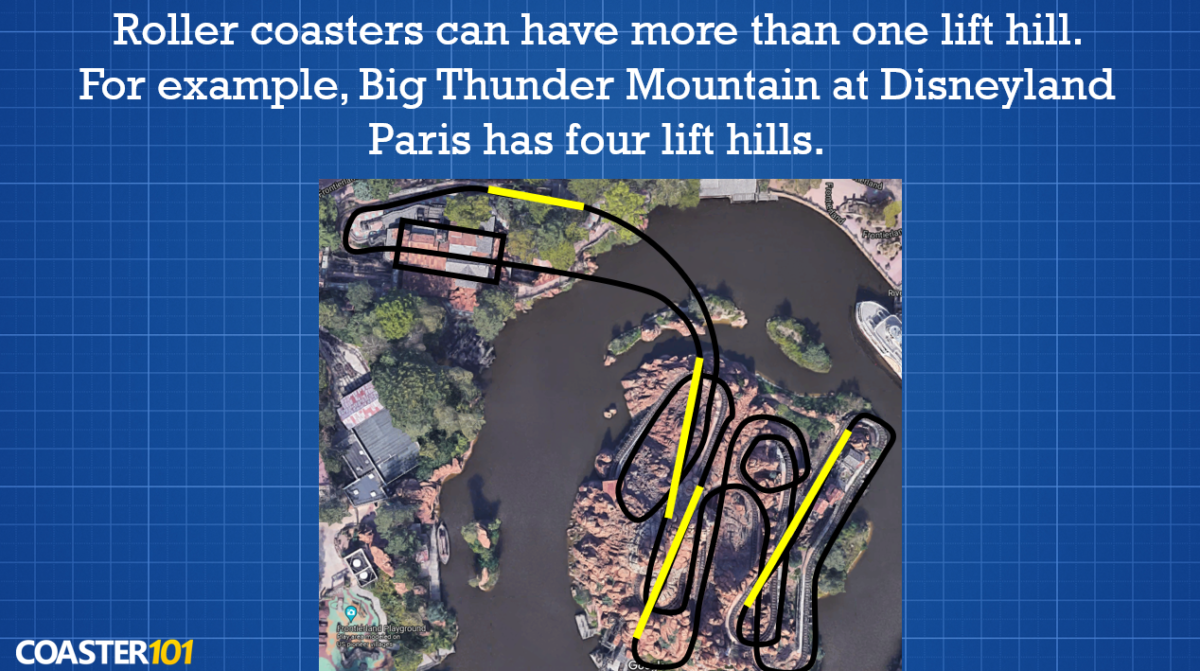
The higher the lift, the greater the amount of potential energy gained by the train. This is shown by the equation for potential energy:
PE=mgh
PE is potential energy, m is mass (kg), g is acceleration due to gravity 9.m/s^2, and h is the distance about the ground (m).
Because mass and gravity are constant for the train, if the height of the train above the ground is increased, the potential energy must also increase. Thus, gravitational potential energy is greatest at the highest point of a roller coaster. As the train accelerates down the hill, potential energy is converted into kinetic energy (and some energy is transferred to heat due to friction, but we’ll discuss more physics in another article).
Differences between lifts and launches
A coaster with only a lift hill depends purely on the height of the lift for its energy. Launch coasters obtain their max energy through other means not directly related to the ride’s height. Some roller coasters, like TMNT Shellraiser at Nickelodeon Universe, have both a lift and a launch.
Lift Hill Design
In the early days of roller coasters, lift hills had a relatively shallow angle of ascent, angled between twenty and thirty degrees. There were very few variations and all looked nearly identical. With today’s technology, lift hills can have any angle of ascent.
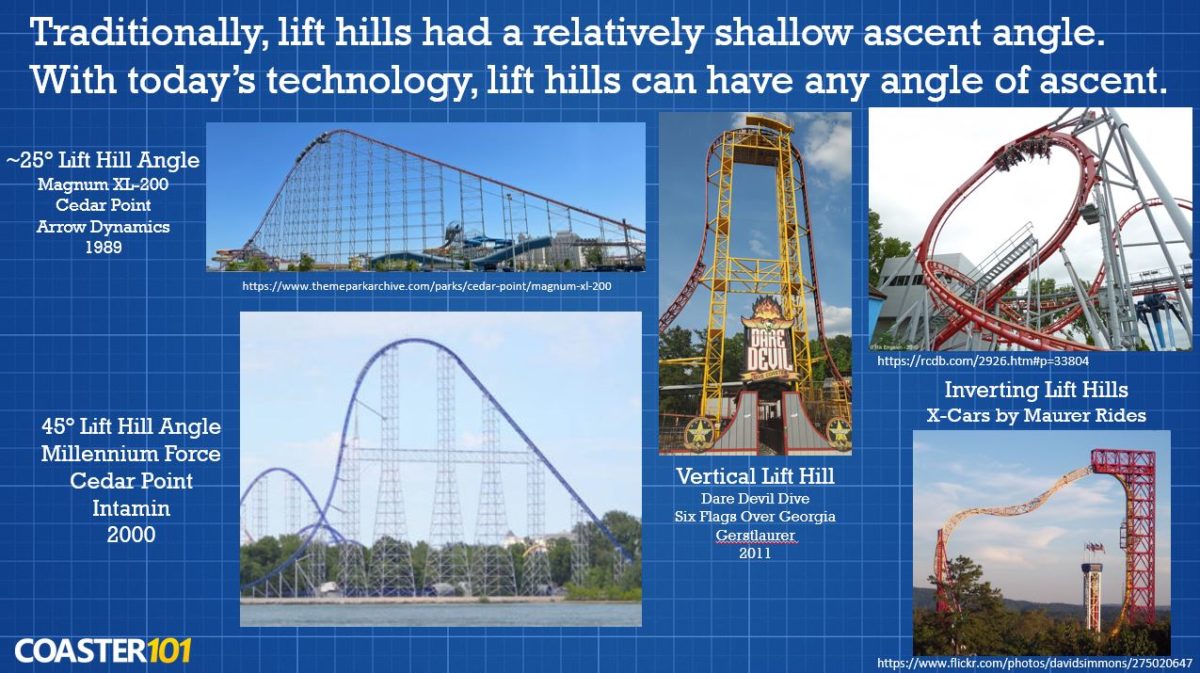
Maurer Sohne builds some of the craziest looking lift hills including some that even go upside down! For example, on G-Force at Drayton Manor, riders were pulled up the first half of a vertical loop. After being released from the weird lift, the vehicles finish the loop and complete the rest of the coaster’s twisted layout.
Factors that influence the lift hill design and what type of lift is used include:
- Space available
- Budget
- Noise
- Speed required
- Height of the lift hill
- Method for rescuing riders
- Materials used
- Force on the components
- Rider comfort
- And so on
Roller coaster engineers need to figure out what strength of chain or cable they need, how powerful the motor has to be to pull up a loaded train plus the weight of the chain or cable, how often the chain needs to be replaced, and so on.
Types of Lift Hills
Lift hills come in all different types, shapes, and sizes. With the exception of magnetic (LSM or LIM) lift/launches, every type of lift hill requires a physical component on the vehicles to contact a component on the lift hill.
Traditional Chain Lift
The chain lift is the traditional method of pulling a coaster car to the top of the tallest hill and has been in use for more than a hundred years. An electric motor pulls the vehicle to the top of the tallest hill where its potential energy is now great.
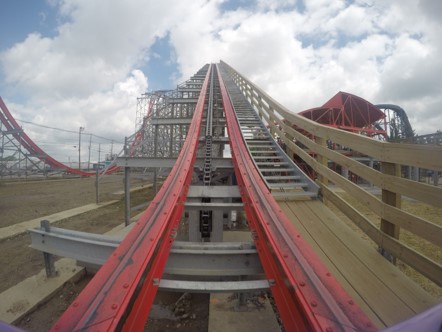
A catch on the bottom of the train, called a “chain dog” or “chain pawl”, engages a chain running in a trough fixed to the center of the track. Why “chain dog”? A pawl is “a pivoted catch designed to fall into a notch on a ratchet wheel so as to allow movement in only one direction”. A “dog” is defined as “a click or pallet adapted to engage the teeth of a ratchet-wheel, to restrain the back action; a click or pawl”. Or “any of various mechanical devices for holding, gripping, or fastening something, particularly with a tooth-like projection.” I’ve heard the terms used interchangeability.
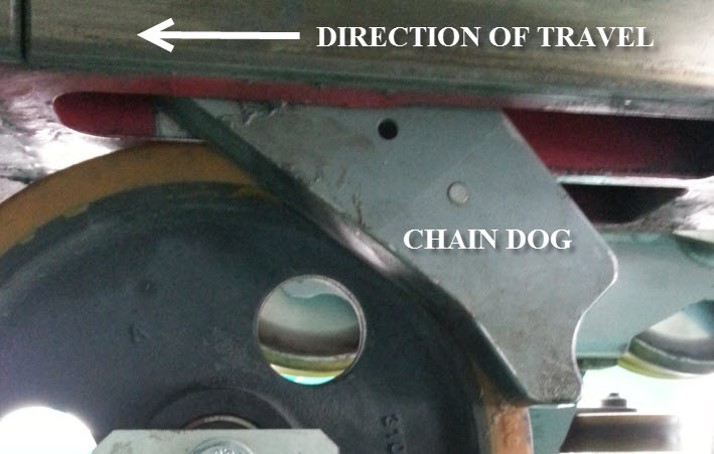
If you want to get even more technical on lift hill chains, watch this video:
Cable (Elevator) Lift
A relatively new variation on the chain lift is the cable or elevator lift. This system allows for a faster, steeper, and quieter ascent up the lift hill. Millennium Force at Cedar Point was the first modern roller coaster to use a cable lift system. This helped reduce the space required for the enormous 310 foot tall lift hill and runs at a rate of around twenty-two feet per second. The cable lift innovation was a key reason why Intamin was chosen as the manufacturer over competitor Morgan, who had proposed a space-consuming chain lift in their bid to build the ride.
Catch Car Lifts
Catch car lifts are primarily used on boomerang style roller coasters as once they pull the coaster train to the top, the catch car releases allowing the train to plummet backwards down the same track it was just pulled up.
Tire Drive Lifts
Also called friction or booster wheel lifts, tire drive lifts are quieter than chain lifts but may also have a harder time operating in wet weather as the system relies on two tires pushing against a fin attached to the underside of the vehicles.
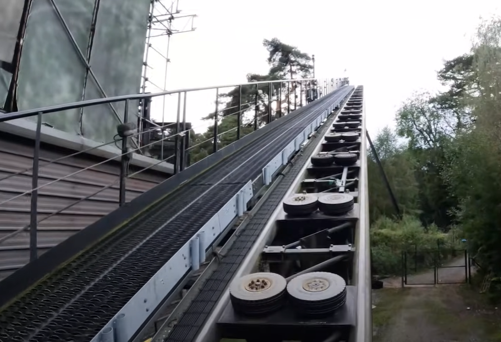
Vertical (Elevator) Lifts
Some roller coasters use vertical lifts to gain their greatest potential energy. These special elevators typically lift a piece of the track straight up where it connects to the big drop or other following elements. This arrangement is mainly used to save space or to provide a unique experience on small to mid-sized rides. The Lost Coaster at Indiana Beach in Monticello, Indiana is a perfect example of a ride that utilizes a single platform vertical lift where one platform raises the cars to the top then must lower back down to raise the next train.
To improve efficiency and reduce the time waiting for the platform to come back down, there is another variation called the double platform lift where there are two platforms connected on a loop, one starting at the top of the tower and the other at the bottom. They pass each other in the middle. This arrangement is seen on taller rides to help improve capacity.
Electric Spiral Lifts
Electric spiral lifts are special in that the vehicles themselves contain small electric traction motors to pull the trains up the hill. The cars engage with an electrified rail on the center of the lift track that provides power to the motors. To keep the weight down the motors have to be small so it is impractical to climb steep lifts, thus most lifts of this type are in an upward spiraling helix to maximize real estate and minimize the grade of the ascent. This system employs anti-rollback devices just as any other roller coaster and once at the top of the lift the train disengages the electrified rail and gravity takes over.
Push Spiral Lift
Another lift hill system in which the track is configured in an upward spiral is called the Push Spiral Lift. However, unlike the electric lift there are no motors attached to the cars. In this case the vehicles are literally “pushed” up the spiral lift hill. A central rotating structure inside of the spiraling track makes contact with a wheel on an arm attached to the vehicle. As the structure rotates the wheeled arm rides up the structure until it reaches the top where the track pulls away from the structure and gravity takes over again. This technology is found in Zamperla’s Flying coasters, three of which exist in the North America, Soarin’ Eagle at Scream Zone (formerly the Flying Coaster at Elitch Gardens), Superflight at Rye Playland, and Timewarp at Canada’s Wonderland, as well as Puss in Boots’ Giant Journey at Universal Studios Singapore.
Ferris Wheel Lift
Another highly unusual device to get the coaster vehicle to its highest point is the Ferris wheel lift. One of these was actually built at Freestyle Music Park (now closed and formerly called Hard Rock Park) in Myrtle Beach, South Carolina. A single car was rolled out of the station and onto a short piece of track attached to a rotatable ring fixed to the inside of a Ferris wheel. The Ferris wheel would complete half a rotation while the track segment stayed upright the entire time thanks to the rotatable ring. After reaching the apex the car would be pushed off at the top into a high speed coaster circuit before returning to the station. Round About / Maximum RPM no longer exists and this was the only Ferris wheel lift ever built due to the low capacity and technical issues associated with always getting the track segments to perfectly align.
Lift/Launch Combos
A roller coaster with a sloped track like a traditional lift hill but uses launch technology (like magnets or friction wheels) to rapidly ascend to the top with some additional kinetic energy is referred to as a lift/launch. Examples are Maverick at Cedar Point, Lightning Rod at Dollywood, and Incredible Hulk at Universal’s Islands of Adventure.
People Powered Sliding Lift
If you travel to Wales in the United Kingdom you’ll find one of the most energy efficient coasters in the world (an eco coaster if you will). The Green Dragon at GreenWood Forest Park is the world’s first people-powered roller coaster. It’s based on an old fashioned inclined railway system developed for mines and quarries intended to move heavy coal down steep slopes without having any external energy source. Here’s how it works:
Riders climb up to the top of a hill level with the coaster’s empty station where they board a funicular (or tram). The tram descends the hill on a track under the weight of the passengers. Through a system of cables and pulleys, the empty coaster train (which weighs less than the combined weight of the tram and passengers) is lifted to the top of the hill on a detached section of track. The passengers then disembark the tram at the bottom of the hill and have to climb another walkway back up to the loading station to board the coaster train. The empty track on which the train was sitting uses gravity to descend back down the hill to await the coaster train at the exit platform, pulling the tram back up to the station level in the process. It’s all about energy transfer: When the passengers climb to the top of the hill they gain potential energy. As the tram descends the potential energy is converted into kinetic energy to pull the train back up the hill.
Lift Hill Safety
Roller coasters must have a way to safely evacuate riders if the lift mechanism fails or the vehicles become stuck. These come in different varieties including evacuation stairs, carts, or the ability to reverse the lift to take the cars back to the ground.
ARBs
On the majority of roller coasters, vehicles are only permitted to travel in one direction up the lift hill. The clack-clack-clack sound you hear as a roller coaster train ascends the lift hill is due to a safety feature known as the anti-rollback (ARB) dog. This device locks into a step arrangement mounted on the lift hill and, in case of chain failure, will hold the entire train in place.
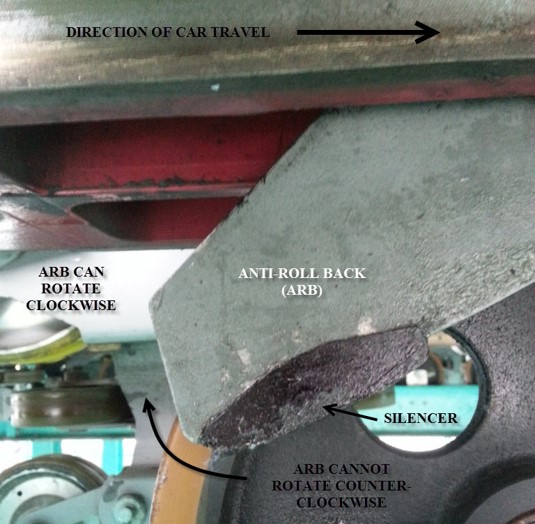
Many theme parks nowadays desire to keep their rides as quiet as possible, either to keep their neighbors happy or so as not to ruin the thematic experience. Some coaster manufacturers use “silencers” such as coating the end of the ARB with urethane or plastic caps as a simple and inexpensive way to dull and deaden the metallic clanking sound. Others use more complicated mechanisms with rails and axles or even magnets to reduce noise and wear.
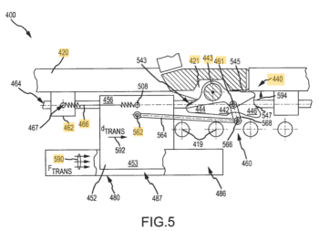
https://patents.google.com/patent/US8020494B2/en
Here’s a great explanation on different types of anti-roll back devices by Art of Engineering:
There are some coasters where the lift hill is purposely designed to let the vehicles roll back down them for extra thrill, such as the Big Grizzly Mountain Runaway Mine Cars at Hong Kong Disneyland using a catch car chain lift system that releases the vehicles to roll backwards, simulating a broken lift.
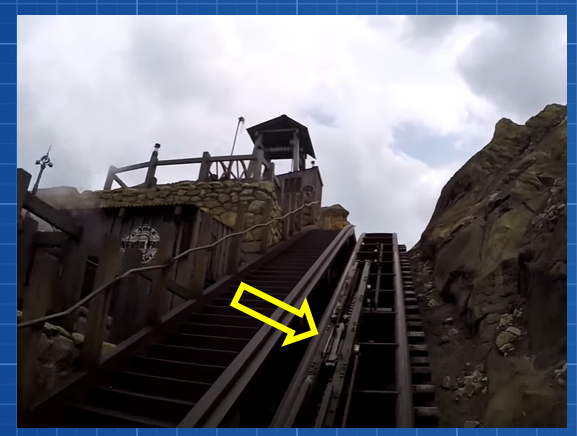
Lift Hill Design Evolution
With improved engineering tools, lift hill support structure has evolved to become more efficient. Thicker track spines result in fewer support columns.
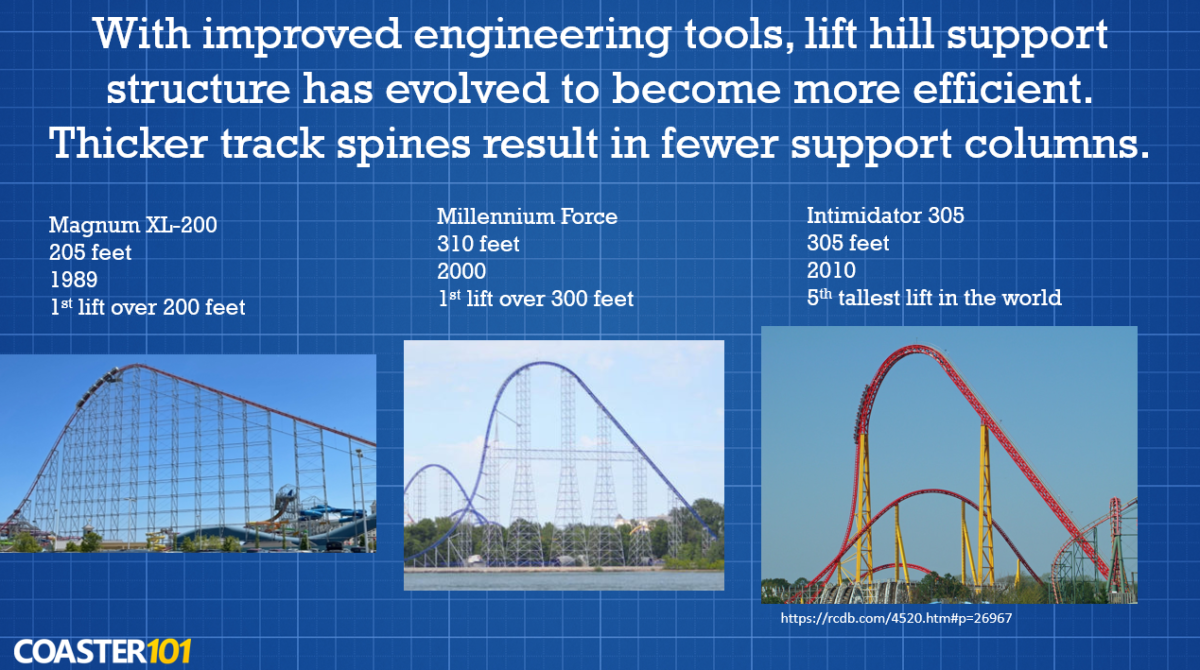
The chain return is now usually located inside the spine of the track rather than a separate component.
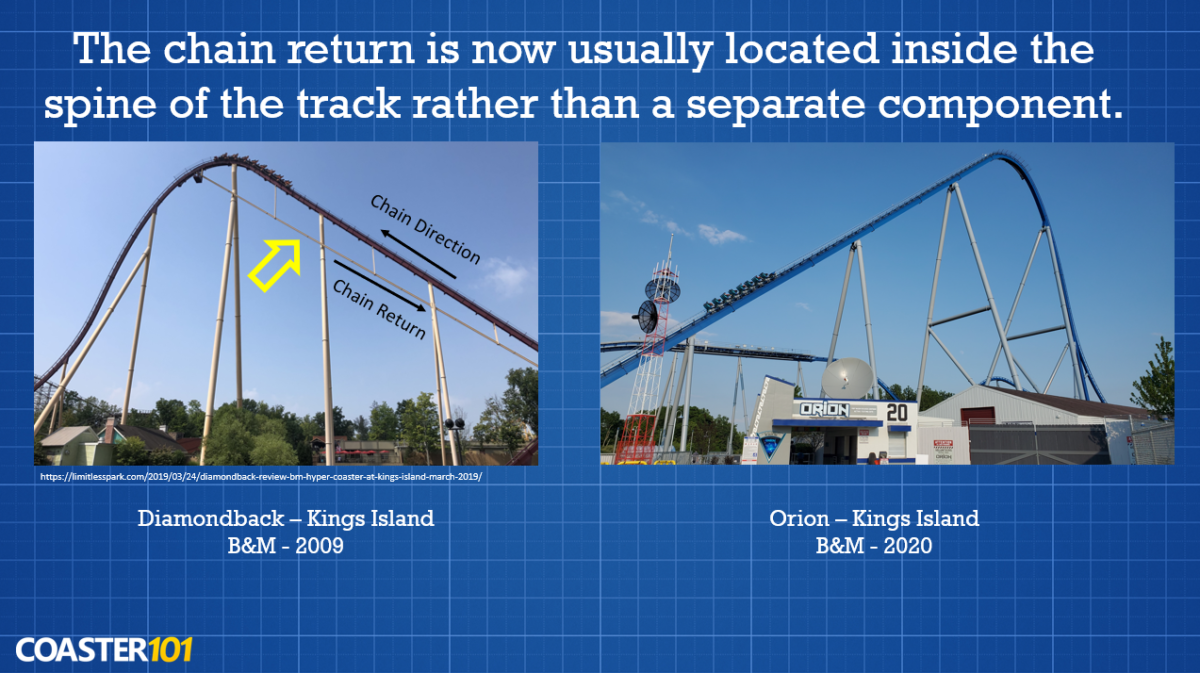
The tallest lift hills on coasters today use “arch shape” support strategies to minimize the amount of structure needed.
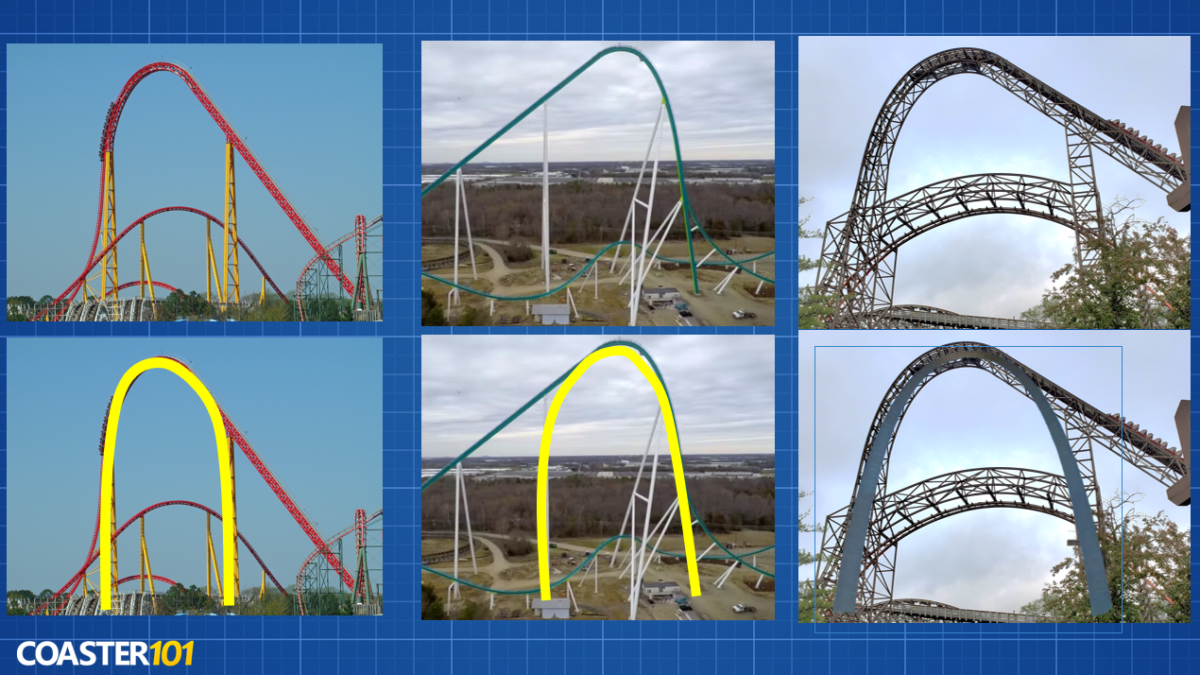
The tallest lift hill in the world is Carowinds’ Fury 325 at 325 feet tall (99.06 meters).
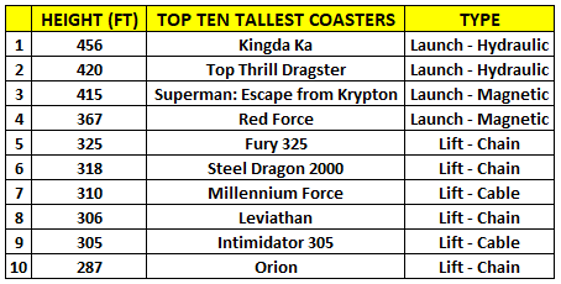
*as of January 2022*
Summary
From a rider experience perspective, lift hills build anticipation for what is to come and can offer incredible views.
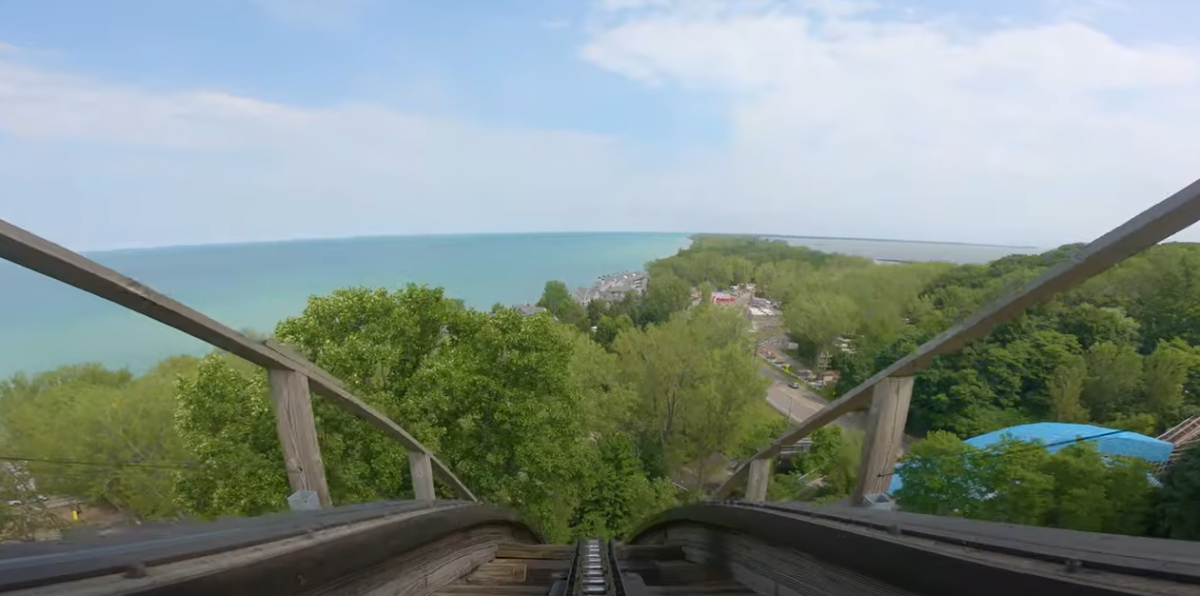
https://www.youtube.com/watch?v=Xmzznhk95IY
Which roller coaster do you think has the best view from the top? Let us know in the comments below!
If you’re a teacher or student and want to download this presentation:
PDF Version (no animations, 5mb, free)
PPT Version (includes animations, 2.2 GB, not free due to file size until I find a better solution)
Click here to read our other Coasters-101 features.
What topic should we cover next? Let us know in the comments below!

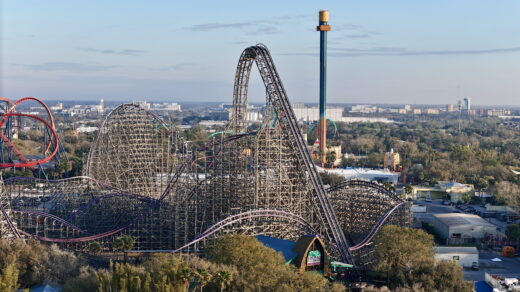
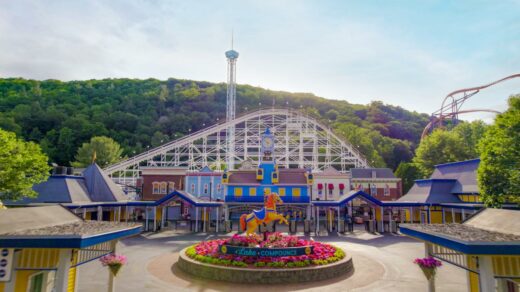
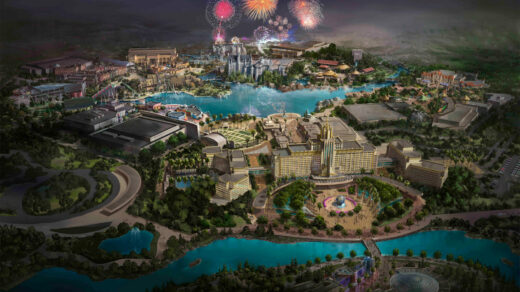




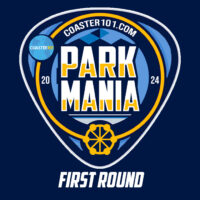




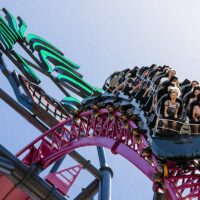
Their as you study my thoughts! You seem to recognize lots about this, just like you had written this ebook there or something that is. I believe that simply is capable of doing by incorporating Per-cent to push the message dwelling a lttle bit, even so rather then that, this is certainly excellent weblog. An excellent examine. I’m going to be backside.
Thank you for this article. Can you explain why the ARD is called a “chain dog”? I’m having a heck of a time finding the origin of that phrase.
The article has been updated.
How do they evacuate Coasters that are suspended or where passengers are moved up backs to the tracks if the train stops.
this article is awesome and so is this website. I was trying to learn about supports and ended up here because of the “arch shape” support system image. Im just a kid whos really curious about how coasters work and this article and website was like a dream come true for all of the questions I’ve ever had about coasters.
Thanks for the kind words so much! Glad to help. If you’re looking for some info on coasters and don’t find it here let us know and maybe that will spawn a new article 😉